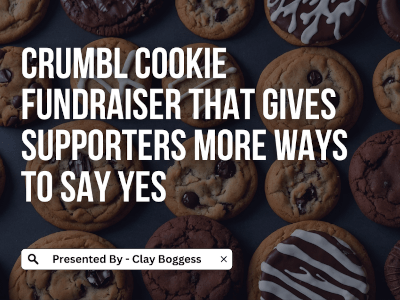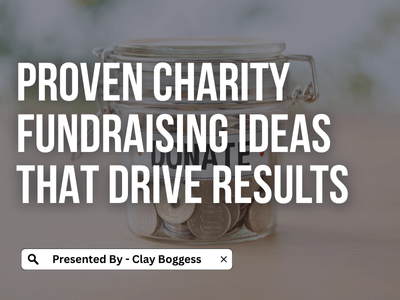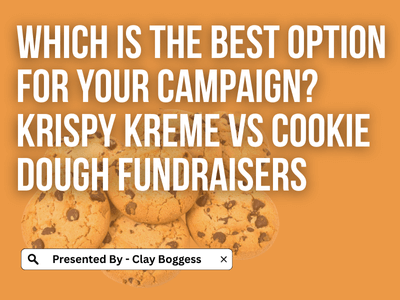
Blog Summary: In this guide, we’ll share practical tips on handling leftover fundraising products so you can maximize your profits and minimize waste. From repurposing unsold items to offering discounts or donating to local charities, there are several creative ways to ensure your fundraising efforts are still a success.
Many schools and organizations face the challenge of handling leftover products after a fundraiser. Whether you’ve hosted a candy bar fundraiser, sold cookie dough, or offered other popular items, it's essential to have a plan for any unsold inventory. Leftover products take up space and can impact your overall profit if not managed effectively.
In this guide, we’ll share practical tips on handling leftover fundraising products so you can maximize your profits and minimize waste. From repurposing unsold items to offering discounts or donating to local charities, there are several creative ways to ensure your fundraising efforts are still a success. Planning and taking the proper steps can turn leftover products into opportunities that benefit your school or organization while keeping the community engaged.
Let’s find the best ways to handle unsold items, ensuring you get the most out of your fundraiser even after the main event ends.
What Are Leftover Items at a Fundraiser?
Leftover items at a fundraiser refer to unsold products that remain after the fundraising event has ended. These can include candy bars, cookie dough, or other items intended for sale. Surplus inventory often happens when more products are ordered than needed, sales targets aren’t met, or the community’s interest in the items is lower than expected. Excess inventory can cut profits and create storage or waste issues, especially if the products expire.
Careful planning is essential to avoid surplus inventory. Begin by accurately estimating how much product you'll need based on the size of your group and expected participation. Monitoring sales trends from previous fundraisers can also help with better projections. Another strategy is choosing non-perishable items, such as spirit wear or custom tumblers, which don't have expiration dates and can be stored for future use.
If you choose products with expiration dates, such as food items, managing them carefully is essential. Set clear sales deadlines and promote the fundraiser to ensure items move quickly. Additionally, having a backup plan, like offering unsold products at discounted prices or donating to local organizations, can help minimize loss.
How To Estimate The Quantity Of Inventory To Purchase For Such Events
When planning a fundraiser, estimating the right amount of inventory is crucial for success. Over-ordering can lead to wasted resources, while under-ordering may cause you to miss out on sales. By carefully estimating your inventory needs and following these tips, you can avoid unnecessary surpluses and ensure a successful fundraiser. Here’s how to accurately assess the quantity of inventory you’ll need:
Know Your Audience
The first step is having clarity about who will be buying your products. Consider the size of your group and the potential reach of your fundraiser. Are you targeting just students and parents or the larger community as well? Knowing the scope of your audience will help you determine how much product to order.
Set Clear Sales Goals
Establish specific goals for how much you hope to raise and how many products need to be sold to meet that target. If you’re selling candy bars, for example, decide how many each participant is expected to sell. Clear goals allow you to make more accurate inventory calculations.
Use Historical Data
If your school or organization has held similar fundraisers, use those numbers as a guide. Historical data can provide insight into which products were most popular and how much was sold, helping you avoid over- or under-ordering.
Factor in Participation Rates
Not everyone in your group may participate, so factoring in participation rates is essential. Estimate how many people will sell products and base your inventory on this adjusted number rather than the whole group.
Start Small with Reorders in Mind
Consider starting with a smaller initial order and reordering if necessary to avoid large surpluses. Many fundraising companies allow reorders, ensuring you don’t overcommit to large quantities upfront.
Choose Non-Perishable Items When Possible
Managing inventory becomes even more critical for fundraisers involving food or other perishable products. Opting for non-perishable items can help reduce the risk of spoilage and waste.
Tips To Prevent Leftover Products During Fundraisers
Preventing leftover products is critical to maximizing your fundraiser’s success. By planning carefully and using innovative strategies, you can avoid over-ordering and ensure that all items sell out. Below are some valuable tips to help you prevent leftover products during your next fundraiser.
Accurately Estimate Product Needs
One of the most critical steps in preventing leftover inventory is estimating how much product you’ll need. If applicable, start by looking at past fundraisers for reference. Consider factors such as the number of participants, your sales goals, and the size of your target audience. It’s better to begin with a conservative estimate and increase orders later if necessary rather than overcommitting and being left with excess.
Set Realistic Sales Goals
Setting achievable sales goals for each participant helps create a clear roadmap for success. Rather than leaving it up to each seller, assign a specific number of products to sell based on your fundraising targets. This keeps sellers focused and ensures that the number of products ordered aligns with what’s realistically achievable.
Use a Pre-Sale Approach
One effective way to prevent leftover products is to take pre-orders before placing your entire inventory order. A pre-sale approach allows you to gather buyers' commitments and order the exact amount of product needed to fulfill those commitments. This strategy benefits food items or products that may expire or go to waste if unsold.
Choose Non-Perishable Products
Opting for non-perishable products, such as custom merchandise or household items, can reduce the risk of ending up with unsellable leftovers. Unlike food products, non-perishable items that have a longer shelf life can be stored for future events if they don’t sell immediately. This flexibility helps minimize waste and loss.
Actively Promote the Fundraiser
Engagement is critical to preventing leftover products. Ensure you actively promote your fundraiser through various channels, including social media, emails, and newsletters. Encourage participants to share the fundraiser with their networks and consider offering incentives or prizes for top sellers. The more visibility your fundraiser has, the faster products will sell, reducing the risk of unsold items.
Set a Clear Deadline
Setting a strict deadline for the fundraiser's end helps create urgency, motivating buyers to purchase sooner rather than later. Clear deadlines also allow you to gauge the time left to push remaining sales. In the last few days, a final promotional push can significantly improve clearing out the remaining inventory.
Offer Discounts Near the End
If you find unsold products near the fundraiser's end, consider offering a small discount or bundle deal to encourage purchases. This strategy can help clear out remaining items while still bringing in revenue, reducing the risk of surplus. It also gives buyers a final incentive to support the fundraiser before it concludes.
Tips To Manage Leftover Products After The Fundraiser
After a successful fundraiser, managing leftover products can be a challenge. Here are some effective strategies to ensure that these items are put to good use and help maximize the impact of your fundraising efforts.
Assess the Leftovers
Begin by conducting a thorough inventory of the leftover products. Categorize items based on their type, condition, and potential for resale or donation. This will help you learn what you have and determine the best action.
Donate to Local Charities
One of the most impactful ways to manage leftover products is to donate them to local charities or community organizations. Reach out to shelters, food banks, or schools that may benefit from your items. Not only does this support those in need, but it also improves your organization’s reputation within the community.
Host a Clearance Sale
Consider organizing a clearance sale if donating isn’t feasible for all items. This allows you to recoup some costs while clearing out inventory. Promote the sale through social media, email newsletters, and community boards to attract buyers.
Recycle or Upcycle
For damaged products that cannot be sold or donated, look into recycling or upcycling options. Research local recycling programs or creative ways to repurpose items. This helps reduce waste as well as gives inspiration for future fundraising ideas.
Evaluate for Future Fundraisers
Finally, this experience can inform future fundraising efforts. Analyze which items sold well and which didn’t, and consider soliciting feedback from your supporters. This insight will be invaluable for planning more effective fundraisers down the line.
Wrapping Up
Effectively managing leftover products after a fundraiser can uplift your organization’s impact and foster goodwill in your community. By assessing inventory, donating items, hosting clearance sales, and considering recycling options, you can ensure that surplus goods don’t go to waste. These strategies support local causes and provide valuable insights for future fundraising efforts.
If you’re looking for innovative fundraising ideas and high-quality products to maximize your next campaign, check out Big Fundraising Ideas. We offer various fundraising products, from delicious snacks to unique gifts, ensuring you have the best options to engage your supporters. Learn how to improve your fundraising efforts with our help and make a lasting difference in your community!
FAQ
- Can you re-use items for a later fundraising event? You can reuse leftover items for a future fundraiser, provided they are non-perishable or have a long shelf life. Items like spirit wear, custom mugs, or reusable water bottles are ideal. However, if you’re selling perishable goods like candy or food items, they may have expiration dates, making them unsuitable for reuse. Proper storage is crucial so that the products remain in good condition. Reusing products can save costs on future fundraising events and help avoid waste, but checking the quality before offering them again is crucial.
- What types of items are suitable for fundraiser events? The best fundraiser items are those with broad appeal, practical use, and affordable pricing. Popular choices include candy bars, cookie dough, custom T-shirts, and branded water bottles. These items cater to a broad audience, making them easy to sell. Additionally, products like discount cards or raffle tickets are effective because they provide value to the buyer beyond the initial purchase. Non-perishable items are often more convenient because they don’t require immediate selling and can be stored for future use.
- If there are leftovers, can you return them and get a refund from the sellers? Whether you can return leftover items depends on the seller’s return policy. Some fundraising companies allow returns on unsold items, offering partial or full refunds, but this varies. It’s essential to check with your supplier before placing an order. Most companies require that the items be in their original packaging and unused. Before the fundraiser begins, a clear concept of the return policy can help you manage leftover products and reduce financial loss.
- What are popular items that sell quickly at fundraisers? Candy bars, cookie dough, and popcorn are highly popular items that sell quickly at fundraisers due to their broad appeal. However, they are also products with expiry dates, and hence, it is wiser to calculate the inventory requirement accurately and pace limited orders to make the most through the sales. Branded merchandise like T-shirts, water bottles, or hats also perform well, especially if personalized for a school or sports team. Products with practical use, such as discount cards or coupon books, are also highly appealing because they offer buyers ongoing value. These items are well-suited for school and community fundraisers and generate high engagement and profit.
- What do we do after the fundraising event? After the fundraising event, it's essential to assess your results, such as how much money was raised and whether you met your goals. You should also review any leftover inventory and decide whether to store, sell at a discount, or donate unsold items. Additionally, thanking volunteers and participants helps build solid relationships for future events. It is always an appreciative gesture to send out follow-up emails or messages to donors to share the fundraiser's success and how the funds will be used to keep your community engaged and ready for future support.
Author Bio
Clay Boggess has been designing fundraising programs for schools and various nonprofit organizations throughout the US since 1999. He's helped administrators, teachers, and outside support entities such as PTAs and PTOs raise millions of dollars. Clay is an owner and partner at Big Fundraising Ideas.



